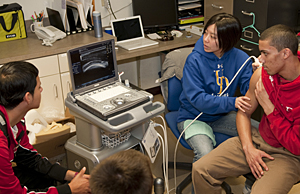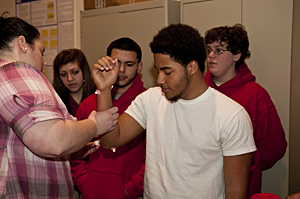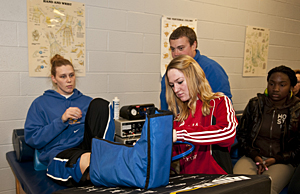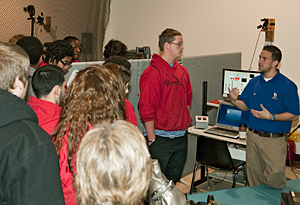


ADVERTISEMENT
- Rozovsky wins prestigious NSF Early Career Award
- UD students meet alumni, experience 'closing bell' at NYSE
- Newark Police seek assistance in identifying suspects in robbery
- Rivlin says bipartisan budget action, stronger budget rules key to reversing debt
- Stink bugs shouldn't pose problem until late summer
- Gao to honor Placido Domingo in Washington performance
- Adopt-A-Highway project keeps Lewes road clean
- WVUD's Radiothon fundraiser runs April 1-10
- W.D. Snodgrass Symposium to honor Pulitzer winner
- New guide helps cancer patients manage symptoms
- UD in the News, March 25, 2011
- For the Record, March 25, 2011
- Public opinion expert discusses world views of U.S. in Global Agenda series
- Congressional delegation, dean laud Center for Community Research and Service program
- Center for Political Communication sets symposium on politics, entertainment
- Students work to raise funds, awareness of domestic violence
- Equestrian team wins regional championship in Western riding
- Markell, Harker stress importance of agriculture to Delaware's economy
- Carol A. Ammon MBA Case Competition winners announced
- Prof presents blood-clotting studies at Gordon Research Conference
- Sexual Assault Awareness Month events, programs announced
- Stay connected with Sea Grant, CEOE e-newsletter
- A message to UD regarding the tragedy in Japan
- More News >>
- March 31-May 14: REP stages Neil Simon's 'The Good Doctor'
- April 2: Newark plans annual 'wine and dine'
- April 5: Expert perspective on U.S. health care
- April 5: Comedian Ace Guillen to visit Scrounge
- April 6, May 4: School of Nursing sponsors research lecture series
- April 6-May 4: Confucius Institute presents Chinese Film Series on Wednesdays
- April 6: IPCC's Pachauri to discuss sustainable development in DENIN Dialogue Series
- April 7: 'WVUDstock' radiothon concert announced
- April 8: English Language Institute presents 'Arts in Translation'
- April 9: Green and Healthy Living Expo planned at The Bob
- April 9: Center for Political Communication to host Onion editor
- April 10: Alumni Easter Egg-stravaganza planned
- April 11: CDS session to focus on visual assistive technologies
- April 12: T.J. Stiles to speak at UDLA annual dinner
- April 15, 16: Annual UD push lawnmower tune-up scheduled
- April 15, 16: Master Players series presents iMusic 4, China Magpie
- April 15, 16: Delaware Symphony, UD chorus to perform Mahler work
- April 18: Former NFL Coach Bill Cowher featured in UD Speaks
- April 21-24: Sesame Street Live brings Elmo and friends to The Bob
- April 30: Save the date for Ag Day 2011 at UD
- April 30: Symposium to consider 'Frontiers at the Chemistry-Biology Interface'
- April 30-May 1: Relay for Life set at Delaware Field House
- May 4: Delaware Membrane Protein Symposium announced
- May 5: Northwestern University's Leon Keer to deliver Kerr lecture
- May 7: Women's volleyball team to host second annual Spring Fling
- Through May 3: SPPA announces speakers for 10th annual lecture series
- Through May 4: Global Agenda sees U.S. through others' eyes; World Bank president to speak
- Through May 4: 'Research on Race, Ethnicity, Culture' topic of series
- Through May 9: Black American Studies announces lecture series
- Through May 11: 'Challenges in Jewish Culture' lecture series announced
- Through May 11: Area Studies research featured in speaker series
- Through June 5: 'Andy Warhol: Behind the Camera' on view in Old College Gallery
- Through July 15: 'Bodyscapes' on view at Mechanical Hall Gallery
- More What's Happening >>
- UD calendar >>
- Middle States evaluation team on campus April 5
- Phipps named HR Liaison of the Quarter
- Senior wins iPad for participating in assessment study
- April 19: Procurement Services schedules information sessions
- UD Bookstore announces spring break hours
- HealthyU Wellness Program encourages employees to 'Step into Spring'
- April 8-29: Faculty roundtable series considers student engagement
- GRE is changing; learn more at April 15 info session
- April 30: UD Evening with Blue Rocks set for employees
- Morris Library to be open 24/7 during final exams
- More Campus FYI >>
3:40 p.m., March 8, 2011----Sixty students from the Henry C. Conrad Schools of Science got a crash course in athletic training research techniques and clinical practice during a visit to the University of Delaware on Wednesday, March 2, as part of National Athletic Training Month.
Conrad is a grade 6-12 magnet program focusing on biotechnology and allied health. The 10th through 12th graders who visited UD are currently taking courses in sports medicine and exercise science.
Three doctoral students in the interdisciplinary Biomechanics and Movement Science (BIOMS) program at UD -- Kathy Liu, Alan Needle and Laura Miller -- demonstrated research techniques including musculoskeletal ultrasound, joint stiffness testing and biomechanical motion analysis in UD's Human Performance Laboratory.
Miller outfitted Ronald S., who plays tennis and football at Conrad, with reflective markers, identifying each anatomical location as she worked. She then asked him to mimic an activity from each of his two sports.
The rest of the students crowded around the computer screen, which showed stick-figure Ronald simulating a tennis serve and a football move. Pointing at the image, Miller said, “Once we know the position of his markers, we can calculate velocity, mass, and forces. Biomechanics is all about physics.”
“This technology allows us to see how an athlete moves and then take that one step further to develop an intervention,” she added. “Our focus in athletic training is on preventing injury and finding ways to keep athletes healthy.”
In the Bob Carpenter Center training room, graduate assistant athletic trainer Craig Oates explained the RICE -- rest, ice, compression, elevation -- strategy for treatment of acute injuries and then showed the young students a cold compression boot, which combines all four functions in one device. He demonstrated it first on Conrad student Kelvin M. and then on injured UD basketball player Sarah Acker.
“It will become uncomfortable for her after the first few minutes,” Oates explained, “but it's essential to get started with this treatment as soon after injury as possible. Tonight, we'll tape her so that she doesn't wake up tomorrow with her leg looking like a grapefruit.”
The half-day visit was coordinated by Renee Allen, math department coordinator and athletic trainer at Conrad, along with UD's John Smith, head athletic trainer, and Tom Kaminski, professor and director of athletic training education.
“Most of the students have been in our training room at Conrad, either observing or as injured athletes themselves,” Allen said, “but it's different when they get out of their comfort zone and into the real world to see what goes on elsewhere and how the things we talk about in class are put into action.”
“The visit to the Human Performance Lab also allowed them to see that there is more to sports medicine than just the training room -- they can do research as well,” she continued. “They were amazed at the research projects and enjoyed the hands-on approach the graduate students took with them at the various stations. These kinds of experiences can open doors and provide high school students with new possibilities to consider for their future studies -- things they knew little or nothing about prior to the trip.”
“These types of field trips are invaluable for high school students, and I greatly appreciate the time the UD students and staff took to spend with them.”
The field trip also included an afternoon visit to the sports medicine facility at the Nemours/A.I. duPont Hospital for Children, one of UD's partners in the Delaware Health Sciences Alliance.
Article by Diane Kukich
Photos by Doug Baker



